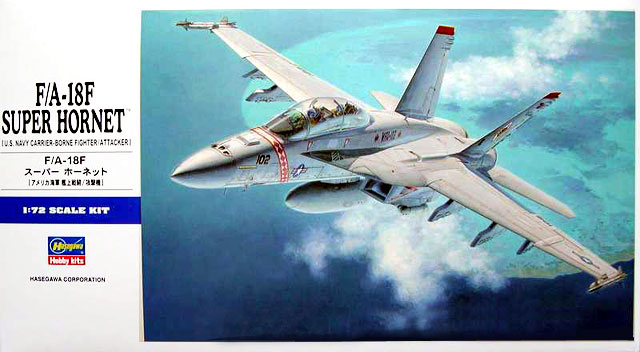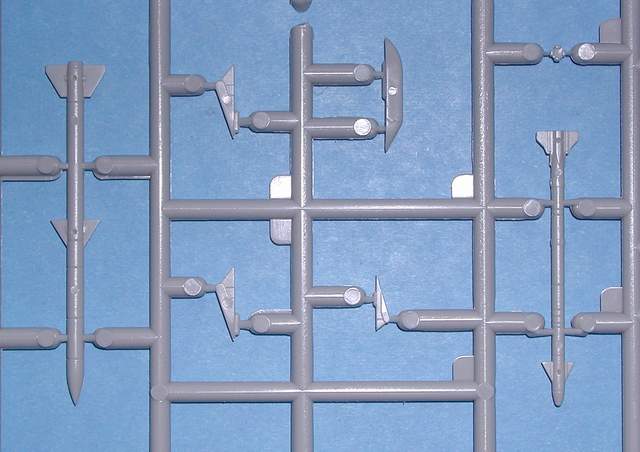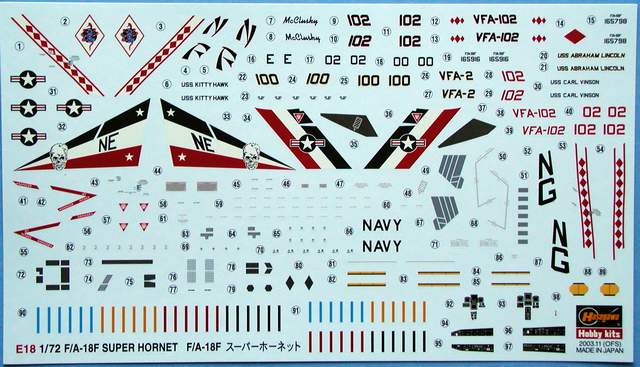|
F-18F Super Hornet

Hasegawa,
1/72 Scale
S u m m a r y
|
|
Catalogue Number: |
E18 |
|
Scale: |
1/72 |
|
Contents and Media: |
98 light grey
styrene parts (1 not used); 3 clear parts; and 4 polythene caps (two not
used). |
|
Price: |
$34.15 CDN |
|
Review
Type: |
FirstLook
|
|
Advantages: |
Reflects
production version of aircraft; positionable elevator surfaces; poly-cap
elevator attachment; two piece canopy; AIM-120 and AIM-9X armament; three
colorful marking options. |
|
Disadvantages: |
Some ejector
pin marks; lack of underwing munitions; rivets. |
|
Recommendation: |
Highly
Recommended |
Reviewed by Dan Lee

Hasegawa's 1/72 scale F/A-18F Super Hornet
will be available online from
Squadron.com
The McDonnell Douglas (now Boeing) F-18F is the latest two
seat evolution of the Hornet family.
Hasegawa's first F-18 Super Hornet in 1/72 scale comprises 98
light grey styrene parts (1 not used); 3 clear parts; and 4 poly caps (two not
used). All 10 grey sprues are squeezed into a single plastic bag. Clear parts
are sealed into a separate plastic bag. Decals and Instructions are floating
in the box.

Click the thumbnails below to view larger
images:
Surface texture is good with crisp, fine engraved panel lines
and hundreds of tiny, recessed holes representing the rivets on the wings,
upper and lower fuselage. A coat of paint will probably hide the rivets. The
ECS heat exhanger exhaust ducts are correctly molded; represented as
rectangular openings on the rear upper fuselage deck. The ECS auxilary intake
doors are represented as raised panel detail. The starboard ECS aux. Intake
door is off center. Don't know if this is an error.

Parts breakdown is similar to the Italeri kit; but appears to
be simpler and easier.
The forward nose and lower fuselage is broken down into three
parts; left, right and lower insert. The IFF interrogator antenna box is
included. The cannon port is represented by a vertical hole; odd so there's
some work to fix this. Cockpit tub is devoid of any detail. Decals are
provided for main and side instrument panels.
The remaining fuselage consists of upper and lower parts. The
fuselage breakdown supports the single seat F-18E. A new rear cockpit
cover/upper deck and canopy is required.
The air intake assemblies are two piece and appear to be
easier to build compared with Italeri's offering. Intake trunking is shallow
with no compressor face; there's just a blank wall. Landing gear bays are
fully boxed with enough detail to satisfy most 72nd builders.
The Wings are separate parts; upper half with lower insert
assemblies. Wing flaps and slats surfaces are molded in the raised position.
To show off the flaps in the typical lowered position, some work is required.
For underwing stores two AIM-120, two AIM-9X, and four 480
Gallon Fuel tanks are provided. A fuselage mounted AN/AAS-38 FLIR pod is also
supplied. The weapons pylons appear to have the correct 4 degree toe out. The
AIMs are well done for 1/72 scale and the AIM9X is the first to be seen in
recent memory.

The colourful decal sheet supplies markings for three US Navy
Super Hornets (2003 VFA-102 DiamondBacks, 2002 VFA-102 DiamondBacks and VFA-2
Bounty Hunters) in the same basic scheme of FS36320 grey upper surfaces, with
FS36375 grey lower surfaces/undersides.

Instructions are typical Hasegawa fare with construction
called out over 13 steps using extensive diagrams and sporadic descriptions.
Hasegawa's F-18 Super Hornet was announced couple years ago
and then disappeared. But with the F-18F release, the wait is over and worth
it. The decal sheet provides for some colorful birds.
The F-18E single seat release is due out in Q1 2004.
For those on a budget the Italeri F-18E/F is half the price,
but it has it faults and requires a fair amount of work.
Recommended.
Text and Images Copyright © 2004 by
Dan Lee
Page Created 08 January, 2004
Last updated 12 August, 2004
Back to HyperScale Main Page
|
|
Home | What's
New | Features
| Gallery |
Reviews | Reference
| Forum
| Search